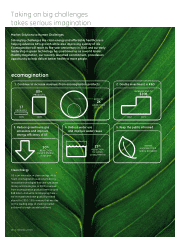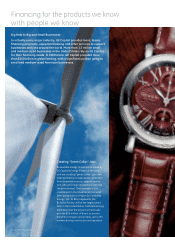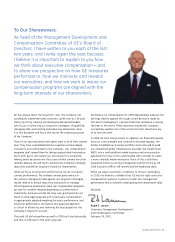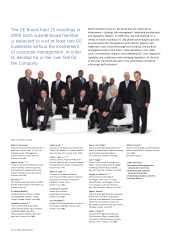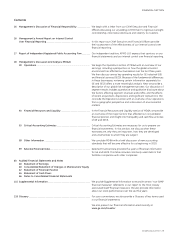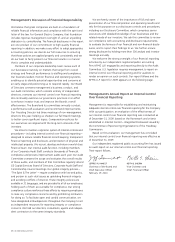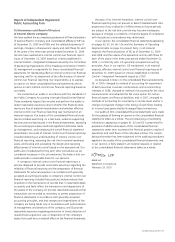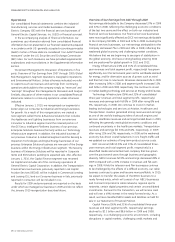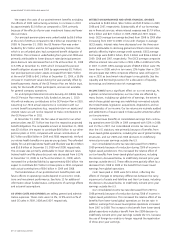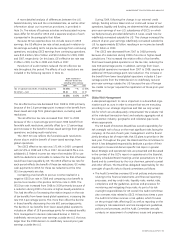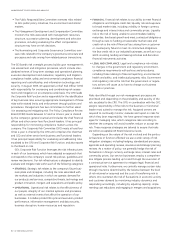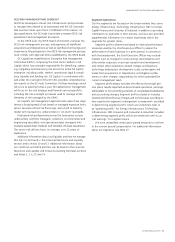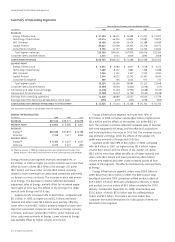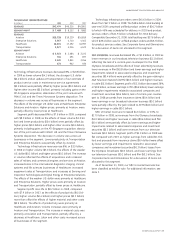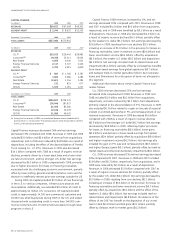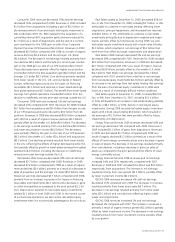GE 2009 Annual Report Download - page 29
Download and view the complete annual report
Please find page 29 of the 2009 GE annual report below. You can navigate through the pages in the report by either clicking on the pages listed below, or by using the keyword search tool below to find specific information within the annual report.
GE 2009 ANNUAL REPORT 27
Report of Independent Registered
Public Accounting Firm
To Shareowners and Board of Directors
of General Electric Company:
We have audited the accompanying statement of financial position
of General Electric Company and consolidated affiliates (“GE”) as
of December 31, 2009 and 2008, and the related statements of
earnings, changes in shareowners’ equity and cash flows for each
of the years in the three-year period ended December 31, 2009.
We also have audited GE’s internal control over financial report-
ing as of December 31, 2009, based on criteria established in
Internal Control — Integrated Framework issued by the Committee
of Sponsoring Organizations of the Treadway Commission (“COSO”).
GE management is responsible for these consolidated financial
statements, for maintaining effective internal control over financial
reporting, and for its assessment of the effectiveness of internal
control over financial reporting. Our responsibility is to express
an opinion on these consolidated financial statements and an
opinion on GE’s internal control over financial reporting based on
our audits.
We conducted our audits in accordance with the standards of
the Public Company Accounting Oversight Board (United States).
Those standards require that we plan and perform the audits to
obtain reasonable assurance about whether the financial state-
ments are free of material misstatement and whether effective
internal control over financial reporting was maintained in all
material respects. Our audits of the consolidated financial state-
ments included examining, on a test basis, evidence supporting
the amounts and disclosures in the financial statements, assessing
the accounting principles used and significant estimates made
by management, and evaluating the overall financial statement
presentation. Our audit of internal control over financial reporting
included obtaining an understanding of internal control over
financial reporting, assessing the risk that a material weakness
exists, and testing and evaluating the design and operating
effectiveness of internal control based on the assessed risk. Our
audits also included performing such other procedures as we
considered necessary in the circumstances. We believe that our
audits provide a reasonable basis for our opinions.
A company’s internal control over financial reporting is a
process designed to provide reasonable assurance regarding the
reliability of financial reporting and the preparation of financial
statements for external purposes in accordance with generally
accepted accounting principles. A company’s internal control over
financial reporting includes those policies and procedures that
(1) pertain to the maintenance of records that, in reasonable detail,
accurately and fairly reflect the transactions and dispositions of
the assets of the company; (2) provide reasonable assurance that
transactions are recorded as necessary to permit preparation of
financial statements in accordance with generally accepted
accounting principles, and that receipts and expenditures of the
company are being made only in accordance with authorizations
of management and directors of the company; and (3) provide
reasonable assurance regarding prevention or timely detection of
unauthorized acquisition, use, or disposition of the company’s
assets that could have a material effect on the financial statements.
Because of its inherent limitations, internal control over
financial reporting may not prevent or detect misstatements. Also,
projections of any evaluation of effectiveness to future periods
are subject to the risk that controls may become inadequate
because of changes in conditions, or that the degree of compliance
with the policies or procedures may deteriorate.
In our opinion, the consolidated financial statements appearing
on pages 60, 62, 64, 66–114 and the Summary of Operating
Segments table on page 34 present fairly, in all material
respects, the financial position of GE as of December 31, 2009
and 2008, and the results of its operations and its cash flows for
each of the years in the three-year period ended December 31,
2009, in conformity with U.S. generally accepted accounting
principles. Also, in our opinion, GE maintained, in all material
respects, effective internal control over financial reporting as of
December 31, 2009, based on criteria established in Internal
Control — Integrated Framework issued by COSO.
As discussed in Note 1 to the consolidated financial statements,
GE, in 2009, changed its method of accounting for impairment
of debt securities, business combinations and noncontrolling
interests; in 2008, changed its method of accounting for fair value
measurements and adopted the fair value option for certain
financial assets and financial liabilities; and, in 2007, changed its
methods of accounting for uncertainty in income taxes and for a
change or projected change in the timing of cash flows relating
to income taxes generated by leveraged lease transactions.
Our audits of GE’s consolidated financial statements were made
for the purpose of forming an opinion on the consolidated financial
statements taken as a whole. The accompanying consolidating
information appearing on pages 61, 63 and 65 is presented for
purposes of additional analysis of the consolidated financial
statements rather than to present the financial position, results of
operations and cash flows of the individual entities. The consoli-
dating information has been subjected to the auditing procedures
applied in the audits of the consolidated financial statements and,
in our opinion, is fairly stated in all material respects in relation
to the consolidated financial statements taken as a whole.
KPMG LLP
Stamford, Connecticut
February 19, 2010



